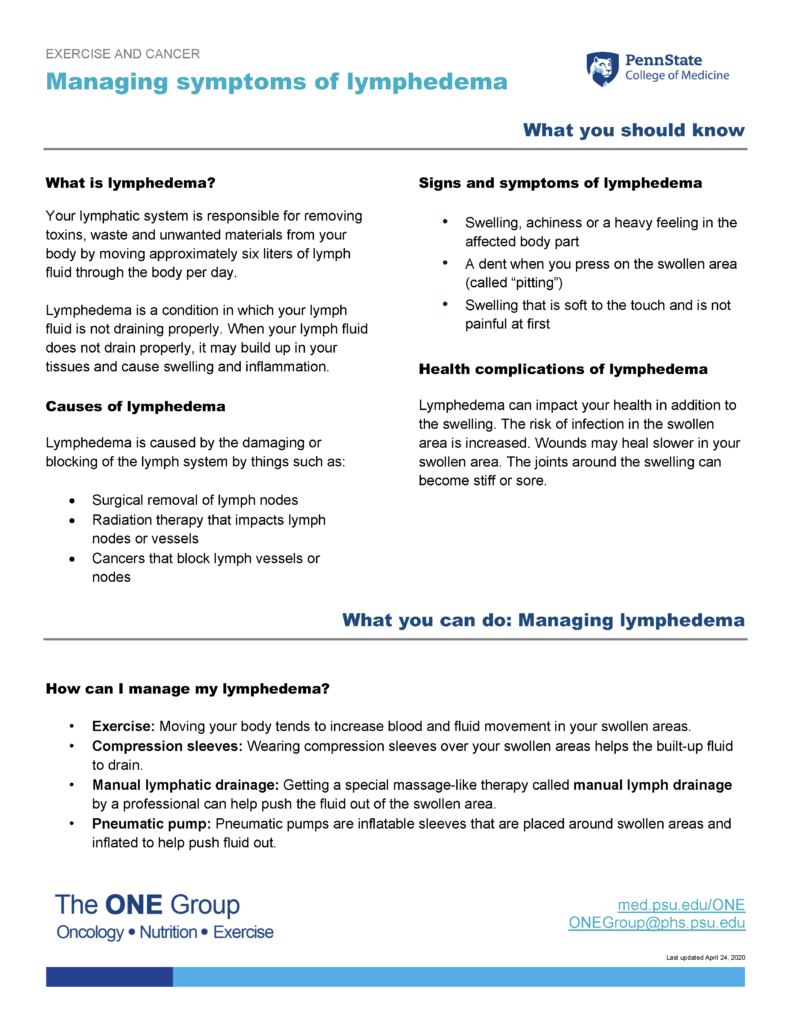Learn about managing symptoms of lymphedema for people with cancer in this guide from The ONE Group (Oncology – Nutrition – Exercise) at Penn State College of Medicine.
Jump to topic
Search
What you should know
What is lymphedema?
Your lymphatic system is responsible for removing toxins, waste and unwanted materials from your body by moving approximately six liters of lymph fluid through the body per day.
Lymphedema is a condition in which your lymph fluid is not draining properly. When your lymph fluid does not drain properly, it may build up in your tissues and cause swelling and inflammation.
Causes of lymphedema
Lymphedema is caused by the damaging or blocking of the lymph system by things such as:
- Surgical removal of lymph nodes
- Radiation therapy that impacts lymph nodes or vessels
- Cancers that block lymph vessels or nodes
Signs and symptoms of lymphedema
- Swelling, achiness or a heavy feeling in the affected body part
- A dent when you press on the swollen area (called “pitting”)
- Swelling that is soft to the touch and is not painful at first
Health complications of lymphedema
Lymphedema can impact your health in addition to the swelling. The risk of infection in the swollen area is increased. Wounds may heal slower in your swollen area. The joints around the swelling can become stiff or sore.
What you can do: Managing lymphedema
How can I manage my lymphedema?
- Exercise: Moving your body tends to increase blood and fluid movement in your swollen areas.
- Compression sleeves: Wearing compression sleeves over your swollen areas helps the built-up fluid to drain.
- Manual lymphatic drainage: Getting a special massage-like therapy called manual lymph drainage by a professional can help push the fluid out of the swollen area.
- Pneumatic pump: Pneumatic pumps are inflatable sleeves that are placed around swollen areas and inflated to help push fluid out.
Lymphedema and exercise
Exercise has been proven to reduce swelling caused by lymphedema. Exercise increases blood flow in swollen areas. Resistance exercise has been shown to be safe and beneficial to women with and at risk for breast cancer-related lymphedema, as long as you start with low resistance and progress slowly.
Try these exercises
Legs: Bicycles
- Lay on your back with your knees bent 90 degrees and your shins parallel to the floor.
- Raise your feet toward the ceiling, keeping a bend in your knees.
- Begin circling your legs as if pedaling a bicycle five to 10 times in each direction.
Arms: Shoulder circles
- Begin standing with your arms to your sides at shoulder height, with palms down.
- Begin rotating your arms in a circle five to 10 times forward and backward.
Where can I find more information about aerobic and strength-training exercises?
If you are interested in starting aerobic and/or strength-training exercises, The ONE Group (Oncology – Nutrition – Exercise) provides videos demonstrating proper form for more than 50 exercises.
Notes
References
- Cancer Exercise Training Institute
- Centers for Disease Control and Prevention
- National Cancer Institute
- National Center for Biotechnology Information

